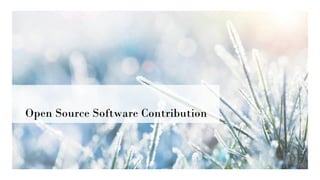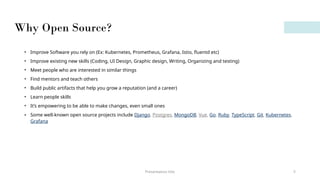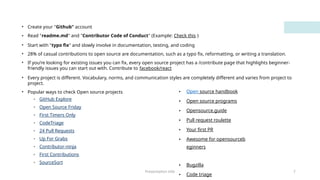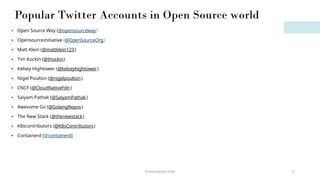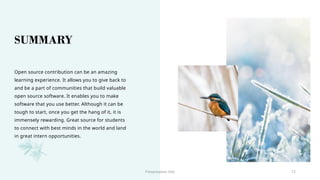contributing to open source in just about any skill
- 1. Open Source Software Contribution
- 2. AGENDA • Introduction • Why Open source? • How to contribute? • Checklist before contributing • Summary Presentation title 2
- 3. INTRODUCTION Contributing to open source can be a rewarding way to learn, teach, and build experience in just about any skill you can imagine and create valuable and accessible open source software, individual contributors can get plenty of personal benefit from contributing to them. Presentation title 3
- 5. Why Open Source? Presentation title 5 • Improve Software you rely on (Ex: Kubernetes, Prometheus, Grafana, Istio, fluentd etc) • Improve existing new skills (Coding, UI Design, Graphic design, Writing, Organizing and testing) • Meet people who are interested in similar things • Find mentors and teach others • Build public artifacts that help you grow a reputation (and a career) • Learn people skills • It’s empowering to be able to make changes, even small ones • Some well-known open source projects include Django, Postgres, MongoDB, Vue, Go, Ruby, TypeScript, Git, Kubernetes, Grafana
- 6. How to contribute? Presentation title 6
- 7. Presentation title 7 • Create your "Github" account • Read "readme.md" and "Contributor Code of Conduct" (Example: Check this ) • Start with "typo fix" and slowly involve in documentation, testing, and coding • 28% of casual contributions to open source are documentation, such as a typo fix, reformatting, or writing a translation. • If you’re looking for existing issues you can fix, every open source project has a /contribute page that highlights beginner- friendly issues you can start out with. Contribute to facebook/react • Every project is different. Vocabulary, norms, and communication styles are completely different and varies from project to project. • Popular ways to check Open source projects • GitHub Explore • Open Source Friday • First Timers Only • CodeTriage • 24 Pull Requests • Up For Grabs • Contributor-ninja • First Contributions • SourceSort • Open source handbook • Open source programs • Opensource.guide • Pull request roulette • Your first PR • Awesome for opensourceb eginners • Bugzilla • Code triage
- 8. Presentation title 8 Anatomy of open source project • A typical open source project has the following types of roles • Author: The person/s or organization that created the project • Owner: The person/s who has administrative ownership over the organization or repository (not always the same as the original author) • Maintainers: Contributors who are responsible for driving the vision and managing the organizational aspects of the project (They may also be authors or owners of the project.) • Contributors: Everyone who has contributed something back to the project • Community Members: People who use the project. They might be active in conversations or express their opinion on the project’s direction • The below files are usually listed in a open source project • LICENSE: By definition, every open source project must have an open source license. If the project does not have a license, it is not open source. • README: The README is the instruction manual that welcomes new community members to the project. It explains why the project is useful and how to get started. • CONTRIBUTING: Whereas READMEs help people use the project, contributing docs help people contribute to the project. It explains what types of contributions are needed and how the process works. While not every project has a CONTRIBUTING file, its presence signals that this is a welcoming project to contribute to. • CODE_OF_CONDUCT: The code of conduct sets ground rules for participants’ behavior associated and helps to facilitate a friendly, welcoming environment. While not every project has a CODE_OF_CONDUCT file, its presence signals that this is a welcoming project to contribute to. • Other documentation: There might be additional documentation, such as tutorials, walkthroughs, or governance policies, especially on bigger projects.
- 9. Presentation title 9 Anatomy of open source project (Cont..) • A typical open source project has the following tools to organize the project • Issue tracker: Where people discuss issues related to the project. • Pull requests: Where people discuss and review changes that are in progress. • Discussion forums or mailing lists: Some projects may use these channels for conversational topics (for example, “How do I…“ or “What do you think about…“ instead of bug reports or feature requests). Others use the issue tracker for all conversations. • Synchronous chat channel: Some projects use chat channels (such as Slack or IRC) for casual conversation, collaboration, and quick exchanges.
- 10. Presentation title 10 Checklist before contributing • Definition of Open Source Software • Does it have a license? Usually, there is a file called LICENSE in the root of the repository. • Does the project actively accepts the contributions? • Look at the commit activity on the main branch. On GitHub, you can see this information on a repository’s homepage. • When was the last commit? • How many contributors does the project have? • How often do people commit? (On GitHub, you can find this by clicking "Commits" in the top bar.) • Look at the project issues: Check the below project issues • How many open issues are there? • Do maintainers respond quickly to issues when they are opened? • Is there active discussion on the issues? • Are the issues recent? • Are issues getting closed? (On GitHub, click the "closed" tab on the Issues page to see closed issues.) • Check the project pull requests • How many open pull requests are there? • Do maintainers respond quickly to pull requests when they are opened? • Is there any active discussion on Pull requests? • Are the pull requests recent? • How recently were any pull requests merged? (On GitHub, click the "closed" tab on the Pull Requests page to see closed PRs.)
- 11. Presentation title 11 Popular Twitter Accounts in Open Source world • Open Source Way (@opensourceway) • Opensourceinitiative (@OpenSourceOrg) • Matt Klein (@mattklein123) • Tim Kockin (@thockin) • Kelsey Hightower (@kelseyhightower) • Nigel Poulton (@nigelpoulton) • CNCF (@CloudNativeFdn) • Saiyam Pathak (@SaiyamPathak) • Awesome Go (@GolangRepos) • The New Stack (@thenewstack) • K8scontributors (@K8sContributors) • Containerd (@containerd)
- 12. SUMMARY Open source contribution can be an amazing learning experience. It allows you to give back to and be a part of communities that build valuable open source software. It enables you to make software that you use better. Although it can be tough to start, once you get the hang of it, it is immensely rewarding. Great source for students to connect with best minds in the world and land in great intern opportunities. Presentation title 12
- 13. Presentation title 13 References • https://stackoverflow.blog/2020/08/03/getting-started-with-contributing-to-open-source/ • https://opensource.guide/how-to-contribute/ • https://www.freecodecamp.org/news/how-to-contribute-to-open-source-projects-beginners-guide/ • https://kubernetes.io/ • https://github.com/grafana/
- 14. THANK YOU Presentation title 14
